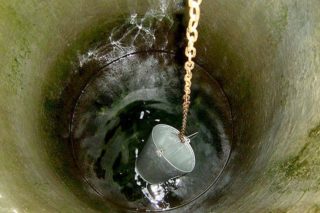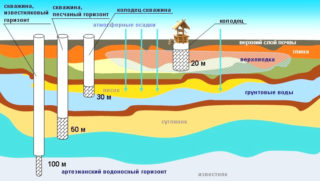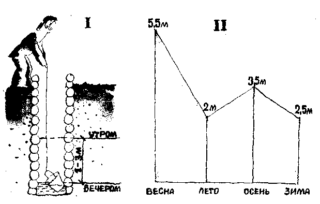Well - a hydraulic structure for regular supply of water to the economy. The most common type is a mine well. It digs when the aquifer is located at a depth of 5-25 m. The filling depends on the type of soil, the thickness and permeability of the formation, the degree of penetration into it. After rain, the water level in the well may rise. This is a common practice. The situation is associated with an increase in the volume of moisture entering the groundwater.
What depth of a well is considered optimal

The walls of the mine-type hydrological structures are reinforced with a wooden blockhouse or concrete rings. In the first case, moisture-resistant tree species are used: oak, pine, larch. The use of concrete rings simplifies and speeds up the work. They are fastened together with metal brackets so that the structure does not interrupt the movement of soil layers. The structure has a square or circular cross section with a diameter of about 1-2 m. The upper part of the well projects 0.8-1 m above the ground.
The depth of the mine depends on the location of the aquifers. They are divided into several types:
- Verkhovodka - the layer lies shallow (1-2.5 m), quickly fills after precipitation and melting snow. Its main disadvantage is pollution. In most regions, overhead fishing is used only for household needs.
- Interstratal waters - located between the water-resistant layers, suitable for any purpose, but require sanitary inspection.
- Artesian - located at a considerable depth (40-100 m), do not require cleaning.
The filling of a well depends on the rate of fluid intake. It can pass through the bottom or oozing from the walls. According to the method of receiving moisture, structures are divided into three types:
- Accumulative - an aquifer of a small pressure, the level resumes 4-10 days.
- Key - settles down on a key, is quickly filled. The disadvantage is the limited amount of fluid.
- River - characterized by a significant depth of the mine and a high level of inflow. The construction is powered by an underground river.
On sandy ground, a column of water rises to 3 rings, the influx is good and stable. Clay soil prevents the quick filling of the mine, but the liquid mirror is kept at ring level 5.
Effect of precipitation on water level
 One of the main factors in changing water levels is weather conditions.
One of the main factors in changing water levels is weather conditions.
Prolonged precipitation leads to a sharp rise in the level of the high water. If the water in the well is at ground level, there is a high probability of loss of waterproofing. Liquid that does not pass through filtration with soil layers enters the mine. Characteristic signs of flooding:
- a sharp increase in water level;
- visual deterioration, turbidity.
When constructing a well from concrete rings, the seams between them are covered with cement mortar. For several years of operation, due to shifts in the soil, earthquakes, sprouting roots of trees, the tightness deteriorates. Through the formed cracks, a top water flows. In this case, you will have to wait for the liquid level to fall, then inspect and repair the mine. A routine check is done every 4-5 years. Timely prevention will prevent flooding of the well. If the well is full after precipitation, it is advisable not to use it until pumping out and resuming the liquid level.
At the stage of the well construction, it is recommended to make a clay castle and a blind area at the top of the structure. According to the rules of SanPiN, around the head it is necessary to build a barrier up to 2 m deep and 1 m wide. Well-mashed clay is used. She is carefully rammed.Negligence in the work leads to the appearance of cracks through which the tip seeps. The castle is formed with a slope from the shaft of the mine. A blind area made of stones or concrete is laid over the clay barrier. The tip of the well is raised by 60-80 cm. A roof is installed above it, which protects against debris.
The reason for the increase in the level may be the abundant filling of the aquifer. After several days of heavy rains or snowmelt, a natural filling of the aquifers occurs. Moisture passes to the level of deep layers and raises the water level in the hydraulic structures that are powered by them.
Seasonal changes in water level
Experienced well owners are aware of variability in moisture levels. It depends on external factors:
- Seasonal fluctuations. This is a natural process associated with the amount of precipitation. If their volume does not exceed 15-20% of the norm, drought occurs. Groundwater has no recharge. They become shallow due to evaporation of moisture. Fluctuations in the liquid level in the mine by season can be 1-4 m. The highest rate is observed in spring and autumn, during the period of massive snow melting and precipitation.
- Shallowing occurs due to large volumes of fluid intake. The well does not have time to fill up.
- Departure of the underground river. It can change the course as a result of tectonic shifts. The installation on another aquifer of another hydraulic structure will also reduce the flow rate of the well.
Raising the liquid level after precipitation is a normal process. It is important to ensure that flooding by the overhead does not occur.



